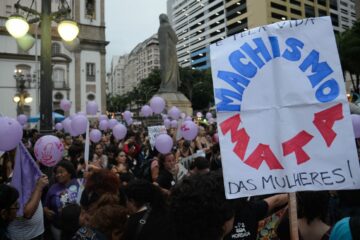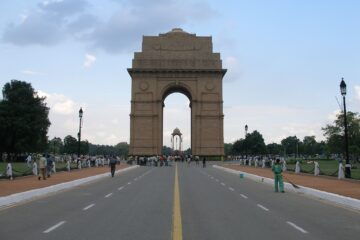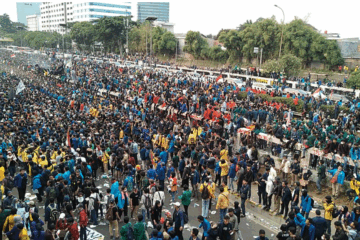At face value, the Santa Anita Park is an infamous but beautiful race track located in a majority-Asian city in Southern California. A backdrop of slender palm trees, purple-y mountains, and blue skies almost distract from the animal cruelty controversies that have circulated the race track and the sport of horse racing in recent years. Upon closer inspection, there are even more layers to the Park’s complicated history. Between 1942 and 1946, the site was homebase to the internment of thousands of Japanese-Americans. Ordained by President Franklin D. Roosevelt’s Executive Order 9066, it was directed that “the Secretary of War and the Military Commanders […] prescribe military areas in such places […] from which any or all persons may be excluded, and with respect to which, the right of any persons to enter, remain in, or leave shall be subject to whatever restriction the Secretary of War or the appropriate Military Commander may impose in his discretion.” In simpler terms, the Order called for the forced relocation of people of Japanese ancestry to concentration camps located on the West Coast of the United States. Over a hundred thousand Japanese living in the United States following Japan’s 1941 attack on Pearl Harbor were sent to live in internment camps. Over 18,000 people of Japanese ancestry were sent to the internment site at the Santa Anita race track. About 8,500 of 18,000 inmates lived in stables and barracks. Sanitary facilities were inadequate and crowded, and cots were the only furniture proved by the military. Those who arrived late had to resort to sleeping on straw bed sacks. Such problems pervaded most internment camps, reflecting a unanimous oversight of basic human rights.
After WWII, Congress’s Civil Liberties Act of 1988 paired with a formal apology from President Roosevelt to affected Japanese-Americans recognized interment to be “a grave injustice” and that “the excluded individuals of Japanese ancestry suffered enormous damages, both material and intangible, and there were incalculable losses in education and job training, all of which resulted in significant human suffering for which appropriate compensation has not been made.” Internment was thereby terminated, but Americans of Japanese ancestry continued to face the after effects for generations to come.
The camps imprinted their victims with long lasting physical, emotional, and economic trauma. According to Donna K. Nagata’s 1993 book “Legacy of Injustice: Exploring the Cross-Generational Impact of the Japanese American Internment,” trauma can directly and indirectly affect the children of former internees, arguing that “despite the silence, or perhaps because of it, [a person born in the US whose grandparents were Japanese immigrants] who had a parent interned felt the effects of that experience in numerous ways.” Phinneas Kiyomura, screenwriter of “Internment”, an upcoming series about living in the camps, and the son of a former internee, says that though his family avoided the topic of conversation “[internment] was a piece of history we just grew up with.” Nagata writes that children of internees experience “feelings of low self-esteem, the pressure to assimilate, an accelerated loss of the Japanese culture and language, and […] the unexpressed pain of their parents.”
The camps also presented long-term health consequences for internees, including psychological anguish and an increased risk of cardiovascular disease. Younger internees were less able to cope with the stress and resultantly were more likely to report post-traumatic stress disorder (PTSD) symptoms and sudden disturbing flashbacks than older internees. According to Gwendolyn M. Jensen’s 1997 book “The Experience of Injustice: Health Consequences of the Japanese American Internment,” internees of all ages were more than twice as likely to be at risk for cardiovascular disease, cardiovascular mortality, and premature death than non-interned individuals. Jensen writes “California [second generation] individuals, the proxy for internment, died 1.6 years earlier than Hawaiians who represented non-interned status. I concluded traumatic stress has life-long consequences even in the presence of efficacious coping strategies.”
Just as clearly, internment burdened its victims with long-term economic impacts, as evidenced by the work of Harvard researchers Daniel Shoag and Nicholas Carollo, who examined the economic consequences of internment. These consequences haunted former internees even 50 years later, and varied in severity depending on the location of the camp where the internee was held. The study highlighted that internees who were sent to wealthier locations were more likely to attend college and earn more money after being released from internment. However, those who were placed in lower-income, rural areas were more likely to receive less education, live in decrepit housing, and earn less money. Economic consequences have had a ripple effect across generations, even affecting internees’ children. Referencing data that spanned fifty years, researchers found that, in 1980, families affected by internment and who had been placed in the poorest camp (Rohwer, Arkansas, USA) were still earning nearly 17% less than those placed in camps located in the most affluent region (Heart Mountain, Wyoming, USA).
Though the injustice of internment was fully recognized by the country decades ago, another similar form of injustice continues to thrive in our modern age. The confinement of Mexican migrants in detention centers at the United States border is currently imprinting victims with long-lasting negative physical, psychological, and economic impacts. Photos from migrant detention centers depict children separated from their families and sleeping on mats on cold flooring, using sheets of foil as blankets.
Long-term detainees have similarly been shown to suffer economically, according to a study by Caitlin Patler, PhD at the University of California, Irvine. Detainees are staggeringly impacted by lost wages, or money that they could have earned to support themselves and their families in the time that they were detained. Among the survey respondents, the detainees shared a total of $12 million dollars in lost wages. Moreover, long-term detention results in even greater economic strain at the individual and household levels. For detainees who considered themselves to be the family breadwinner, their families were likely to have more difficulty paying their rent, mortgage, medical, and utility bills on time, if at all. Like in the cases of Japanese-Americans affected by internment, poverty is compounded from generation to generation. A point from Daniel Shoag and Nicholas Carollo’s paper becomes relevant here: “There may have been discussions about allowing refugees into the country, maybe sending themes to depressed parts of the country to bolster the population [and economy], but when you send a refugee family to a low-income place, that is going to have a huge impact on them, their families, and their future generations.” When we apply this idea to the realities of detained migrants, it becomes undeniably clear that we are standing by as a similar injustice plays out.
Even short periods of detainment can cause emotional and psychological trauma. According to a PBS interview with Doctor Alan Shapiro, the fact that children are separated from their parents heightens their stress levels. The freezing cold temperatures coupled with the reality that children are forced to sleep on the floor due to the lack of accommodations at detention centers makes detainment all the more unsafe and unsanitary. Shapiro asserts that “in the short-term, what we see is children with regressive behavior.” This kind of behavior includes becoming withdrawn, becoming mute, and so on. The constant and augmented presence of the stress hormone cortisol within children at these facilities puts them at a higher risk of learning problems and developmental problems.
The internment of Japanese-Americans during World War II as well as the more recent detainment of Mexican migrants both point to the immorality of depriving select groups of people of basic human rights. If we can recognize the injustice of Japanese internment, let us collectively recognize that these detention centers for Mexican migrants will be a source of shame for all Americans and the culprits behind a lifetime of related consequences for victims.
Featured image by Edoardo Frezet on Unsplash (Unsplash License). Memorial pillar at Manzanar Japanese internment camp.




